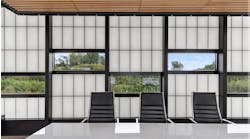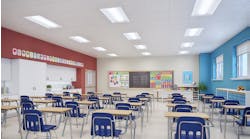Every school and university relies on lighting to provide effective learning environments. But as facility managers learn more about sustainable design and other energy-saving techniques, they can keep their buildings well-lighted and reduce the burden on their budgets.
One approach that has gained wider acceptance in recent years is creating instructional spaces that rely on daylighting for illumination.
In the rush to embrace daylighting for its cost savings and beneficial effect on student performance, school officials don't always recognize that daylighting, in and of itself, will not necessarily improve the learning environment or cut energy costs.
Daylighting in some poorly designed instructional spaces may enter the room too directly and create glare, which can hinder learning.
The U.S. Department of Energy's Office of Energy Efficiency and Renewable Energy (EERE) recommends that a school design should separate windows for viewing the outside from windows meant to bring daylighting into the room.
One method for accomplishing this is a light shelf, “a horizontal light-reflecting overhang placed above eye-level with a transom window placed above it.”
Other methods of enhancing the use of daylight are skylights, clerestory windows, roof monitors, and a sawtooth roof design. The use of baffles to diffuse light throughout an area can increase the effectiveness of a daylighting design.
Integrating a building's daylighting strategy with the electric lighting system is critical to achieve energy savings.
“Only when the electric lighting load is reduced will there be more than offsetting savings in electrical and cooling loads,” the EERE says. “The benefits from daylighting are maximized when both occupancy and lighting sensors are used to control the electric lighting system.”
The sensors will turn lights on only when a room is occupied and only if there isn't enough daylight. Because many teachers prefer to be able to adjust lighting in their classrooms, schools should consider sensor systems that allow a manual override of the automatic settings.
The type of lighting equipment selected for a school can increase energy efficiency. The EERE says that T-8 and compact fluorescent lamps (CFLs), electronic ballasts, and solid-state LED exit signs use energy more efficiently and can significantly reduce lighting consumption and costs.
NOTABLE
25 to 50
Percentage energy savings schools can achieve through carefully planned delamping of general overhead lighting.
20 to 30
Percentage reduction in lighting energy use a school could see by using T-8 fluorescent lighting and electronic ballasts instead of T-12 fluorescent lighting.
60 to 80
Percentage of a school's annual lighting costs that is attributable to electricity.
8 to 20
Percentage of potential energy savings schools can achieve by turning off lights in unoccupied rooms.
Source: U.S. Department of Energy's “School Operations and Maintenance: Best Practices For Controlling Energy Costs”

